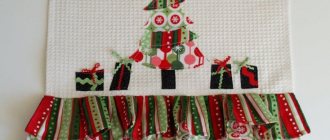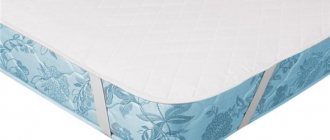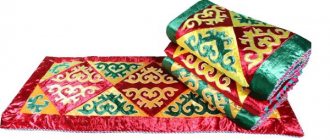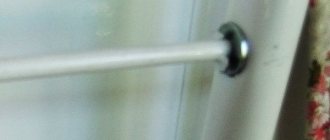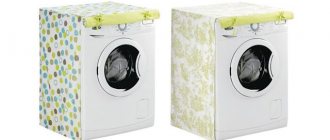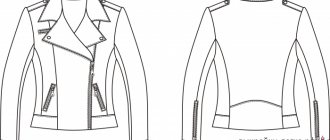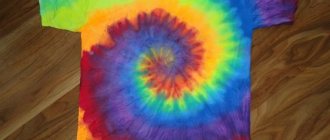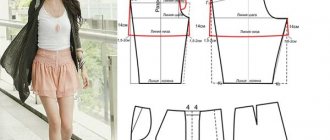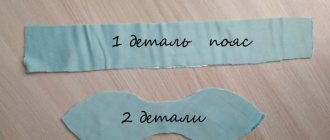Sewing a cover for an ironing board is easy, the main thing is to know how to do it correctly and have a sewing machine. The need to replace the cover may arise if the old cover has worn out, lost its attractive appearance, or was accidentally burned through by a hot iron. During use, the old fabric gradually becomes clogged with dust, and after 10-15 years, when using a dirty board, you may encounter the problem of stains appearing on clean white linen.
Of course, you can purchase a ready-made, new case in the store. But, if you need to replace the fabric on an old-style ironing board that has long been discontinued, it may not fit. In addition, when buying a finished product, you may not be able to guess the dimensions even for a modern board. As a result, the cover will dangle, form wrinkles and complicate the ironing process.
Rules for choosing fabric for a cover
Cotton calico is considered the ideal option for upholstering an ironing board, although other types of fabrics can be used if desired. The main thing is that the material does not stretch. Otherwise, the new case will quickly become deformed.
When choosing fabric, you should also consider the following recommendations:
- The material must be resistant to shedding. When ironing using the steam mode, light-colored items may become dirty from the shedding cover and become unusable. To check whether the material is subject to shedding, you will need to wash it in a basin of warm, clean water. If the water remains clean after washing, then the fabric is suitable for sewing a cover, and vice versa.
- A cover that is too light in color will quickly become dirty and covered with yellow spots from the hot iron. Therefore, it is better to opt for darker colors. If you still like light-colored materials, then you can sew several removable covers and replace them periodically.
- The fabric used to cover the ironing board should not contain additives that will stick to the iron when it heats up. Firstly, you will have to constantly clean the soleplate of the iron so that it glides well on things. And secondly, a dirty sole can easily stain the item you are ironing.
We recommend: How and with what can you wash tiles and porcelain tiles after renovation?
Choosing material for the ironing board
The cover needs to be changed on average every 2 years. What fabric can be used to make a cover for an ironing board? Basic requirements for the material:
- resistant to high temperatures;
- does not shed;
- smooth but not slippery;
- dense.
Preference should be given to cotton, linen or light blended fabrics. It is not recommended to choose chintz - it is too loose, but dense calico, flannel or teak will work perfectly. It is desirable that the canvas be monochromatic. It is better to check variegated fabric for dyeing in advance.
For lining, white batting, felt, padding polyester or thin foam rubber is usually used. It should be borne in mind that foam rubber is not the most durable material - under the influence of humidity and high temperatures it quickly loses its softness. It is better to choose batting or felt - they are quite rough, which means that when ironing the cover will not slide on the board.
Do I need to change the substrate?
Replacing the lining located between the board itself and the fabric may be necessary in the following cases:
- If it became deformed or torn during the process of removing the old fabric.
- If the insulation is old, dirty and stains the laundry when ironing.
- If during use it has become leaky, resulting in the surface of the board becoming uneven.
To make the lining, any insulating material is suitable - foam rubber, synthetic winterizer or batting. You can also use felt or cut a lining from an old flannelette blanket.
How to change the upholstery on an ironing board?
For a wooden ironing board, it is not necessary to sew a cover; you can simply cover the surface with fabric and secure it with a stapler. This option is suitable for those who do not have a sewing machine.
For new upholstery of a standard board, it is enough to purchase 0.8 m of thin fabric and the same amount of batting. The minimum width of the canvas is 150 cm. The most convenient way to secure the upholstery is with a furniture stapler, but if you can’t get one, small post nails will do just fine. They do not need to be hammered in completely; the ends can simply be bent.
To cover a board, you first need to remove the old upholstery (along with the lining) from it. This is done so that, under the influence of moisture, the old cover does not stain the new fabric, especially if it is light.
Read how effective Calgon powder is for washing machines and what cheap analogs exist.
We recommend that you find out what products available in the household can be used to clean mirrors.
How to stretch fabric?
The upholstery should fit perfectly to the tabletop. To do this, you should tighten it in a certain way:
- cut a piece from a piece of insulation to the shape of the table top and glue it to the board in several places with “Momenta” type glue;
- a part of the same shape must be cut from the base material (taking into account allowances of 10-15 cm);
- the fabric is first attached to the back of the board using several staples;
- then you need to pull it forward and place one paper clip in the center;
- after this, the fabric is alternately stretched to the right and left and pinned;
- the edges must be folded inward by 2-3 cm;
- after all the side sections are firmly fixed, you can begin to finally secure the upholstery;
- corners and curves are formed using small folds.
Fabric stretched in this way will not have folds or skewed areas. You don't need to pull it too hard. It is enough that the surface is smooth.
Important: before you start reupholstering, it is advisable to wash the material at high temperature, since cotton fabrics shrink.
Materials for work
So, we have decided on the fabric for the top layer and backing, and now we need to prepare for the process of making the cover. To work you will need:
- Scissors.
- Long ruler or tailor's centimeter.
- A piece of sharpened chalk or soap, or a tailor's pencil specially designed for marking.
- Sewing machine.
- Tailor's pin.
- Threads in the color of the selected material.
- Elastic band or long braid.
- Small round nose pliers.
Types and materials
There are several coverage options in different price categories. To save money, it’s easier to choose a simple and cheap option and change it as it wears out. But you can choose a coating that is more expensive and more functional. Modern, improved cases are considered expensive. Let's look at a few options:
- The cheapest is a cotton cover.
- A case made of synthetic fabric will cost a little more. It is waterproof, non-flammable and does not allow the iron to stick.
- Coverings with metal threads inside, which allow ironing more efficiently. The iron interacts with the metal, heating the fabric on both sides. This significantly improves the ironing process. An iron left on the ironing board can sit for up to 4 hours without burning.
- Option with a non-stick coating, which is made of cotton fabric impregnated with silicone. This impregnation helps protect clothes from burning and yellow spots. In addition, the effect of double ironing occurs, as it heats up from the iron.
- Teflon coated case. It allows you to iron any types of fabrics without burning or sticking, heating clothes on both sides at the same time.
- Another new type of cover of the highest quality, with fire-resistant properties.
Cotton cover - the most inexpensive and common
Removable cover
First you will need to remove worn out, old fabric from the ironing board. This procedure is performed using pliers. Using the sharp end of the tool, pry the bracket, clamp it and carefully pull it out. Thus, it is necessary to remove all the staples that secure the covering to the tabletop.
Next, you need to remove the top fabric and inspect the backing. If it is in good condition, then the material is carefully washed in warm soapy water, dried and ironed with a lot of steam.
Now we proceed directly to cutting and sewing the cover itself. The procedure is performed in the following order:
- We lay the old fabric removed from the tabletop on top of a new piece of material and trace the outline with chalk. If desired, you can turn the board upside down, place it on the fabric and draw the outline of the tabletop. If you need to replace the backing, you will also need to make a pattern from padding polyester or foam rubber. The substrate is immediately fixed to the tabletop with a stapler.
- We make a seam allowance into which we will later thread the elastic. To do this, parallel to the previously drawn contour on the cotton fabric, we lay a line, which should be located at a distance of 6 cm from our contour.
- We cut out the part and put it aside.
- Now we cut the bias tape 10 cm wide, fold it in half along its entire length and iron it.
- We turn the edges of the binding inward by 1 cm and iron it again.
- Next, you need to use a needle and thread to baste the binding around the perimeter of the main part so that an elastic band can be threaded into the resulting drawstring.
- Using a sewing machine, we sew a seam along the basting seam.
- Remove the basting thread and, using a tailor's pin, thread the elastic into the drawstring.
We recommend: How to clean crystal until it shines at home
If a cord is used instead of an elastic band, its ends are fixed with a special stopper. It can be purchased at any sewing supply store. This limiter is very convenient to use, as it is equipped with a locking button that allows you to tighten the cord as tightly as possible.
The cover for the ironing board is ready. All that remains is to put it on the countertop and start ironing the laundry.
How to Renew an Old Ironing Board Cover
It’s already been a year since I did this master class and my cover became worn out during the work, the drawing faded and its shabby appearance did not fit into my cozy workshop. I decided to update the case, and now I’ll show you how quickly and easily it can be done in 10 minutes. All I needed for this was a piece of fabric (poplin) 45 cm.
1. I remove the old cover from the ironing board and take out the elastic band. I smooth it with an iron until it looks flat. I will use it as a pattern.
2. I put the cover on the fabric, cut out exactly the same part using it, without allowances. I cut off 0.5 cm along the entire perimeter from the edge, so the new pattern seems to be slightly smaller.
3. I overcast the edges of the pattern using an overlocker, or you can overcast with a zigzag stitch on a sewing machine. The main thing is that they do not crumble.
4. I place the processed pattern on top of the old cover on the front side. I fasten them together with tailor's pins.
5. From the wrong side, I use a sewing machine to make a straight stitch, trying to get into the elastic seam (point 6 above).
All you have to do is insert the elastic band and the updated ironing board cover is ready!
What is important when choosing a case
A replaceable cover is very important for ironing. It should combine both functionality and practicality. The process must be approached very responsibly and competently. We live in a modern world where even a cover for an ironing board serves as an interior detail and is an accessory. But don’t forget about the main purpose – safe and high-quality ironing of things.
Step-by-step instructions for choosing a case.
- We take measurements of the ironing board. We are interested in length and width. If everything is clear with the length, but as for the width, we measure only the working surface at the widest point. The tabletop requires special attention; its edge comes in different shapes - round, blunt or conical. Take this factor into account too.
- Decide on the coating material. It can be very different; we will consider this point in detail a little further.
- Availability of padding.
- Choose the right mount for your board.
Now let’s analyze the points listed above in detail in order to clarify and make choosing a board overlay as simple as possible.
Padding (backing)
Most often, felt or foam rubber (foam material) is used for padding; the thickness should be from four to eight millimeters. These two materials are good for ironing, but there are differences between them.
Foam padding (foam rubber) ensures surface hardness - the iron glides over the surface better and easier. The felt surface is soft and smooth, dents appear. There are combined options - there is both felt and foam.
Replacing the old cover
The removable cover can always be washed if it gets dirty. However, the fabric gradually becomes unusable, so from time to time the coating requires replacement. There are several ways to apply a new cover to your ironing board.
How to secure
You can sew it yourself by sewing elastic around the edge. If the board is metal or has a mesh surface, you can choose another method. You can insert a rope into the fold of the cover, with which you can tighten the cover on the board.
If the ironing board top is made of wood, it is simply wrapped in fabric, which is secured with furniture clips. This is, of course, the old way of putting a cover on a board, but the cheapest.
Should I remove the old coating?
If the fabric is snow-white, then it is advisable to remove the old coating, as well as its gasket, to avoid contamination on the new cover. If you use colored fabric, this is not necessary. You will only need 0.6 meters of light fabric (cotton, calico) and light batting, their width should be 150 centimeters. Light shades are preferable to bright ones because they will not fade or ruin white items. Instead of a stapler, you can use nails that you can simply bend.
How to quickly put a cover on an ironing board
There is a certain procedure, following which you can correctly, easily and accurately stretch the fabric onto the ironing board tabletop. First, attach the back of the case using three paper clips. After this, you need to tighten the material and secure it with a paper clip in the center. Now you need to pull the fabric to the right and left from the central part and secure it with paper clips. By fixing the sides with two or three paper clips on each side, you can tighten the folds and secure them to all protruding parts of the tabletop. The main thing is that the fabric does not wrinkle. In this way, you can carefully renew the surface of the board.
Covers with drawstrings are suitable for any board size
But it is best to choose a removable cover equipped with drawstrings that allow you to adjust its size to fit any ironing board. Typically, it is correct to use laces, ties, and elastic bands to secure the cover. The disadvantage of a rubber tie is that it will soon stretch, so it is better to give preference to rope. The cover is placed over the surface of the ironing board and tightened to the desired size. The main thing is that it does not fidget on the work surface, but is securely fastened. It is imperative to have a soft lining so that there is no need to lay something on top.
Read also: How to set up a Hyundai TV for digital television
Before going to the store to buy a cover, in order to make the right choice, you should measure the basic parameters, length and width, of the working surface of the ironing board. Most often, covers are made for ironing boards from certain manufacturers. Even if the size is the same, the shape may differ. Therefore, it is necessary to take into account the shape of the board; its nose can be not only blunt, but also cone-shaped and sharp. In this case, before choosing, it is advisable to consult the seller.
Thus, putting on the cover is not a particularly difficult task.
Ironing board cover
Any housewife who cares about home comfort is faced with the periodic need to iron clothes. This process is quite tedious and time-consuming. To make your work easier and avoid damaging your laundry when ironing, it is best to use an ironing board cover, which is easy to use and has several types.
When purchasing an ironing board, buyers pay attention not only to its design, but also to its appearance. The ironing board cover not only plays an aesthetic role, decorating the ironing surface, but also performs several practical functions. So, the material from which the case is made is very important. It’s great if it’s soft and has non-stick properties.
Depending on the price, the cases differ in quality. Cheaper ones are made from cotton fabrics. For more expensive ironing board models, synthetic materials are used that do not allow moisture to pass through and do not stick to the iron.
The sizes of the covers can be different depending on the board for which they are intended: 132 by 48 cm, 124 by 45 cm. Often the ironing board cover is equipped with a special cord, with which you can adjust its size to the surface for ironing, firmly fix and prevent his slippage. Inside it is equipped with a thin layer of foam rubber, which, depending on the brand, ranges from two to four millimeters.
Modern manufacturers care about customers. Thus, you can purchase a removable cover for the ironing board, which makes it easier to use. It becomes possible to wash it, clean it and put it back on the board for further use. The cotton cover makes the cover washable.
Package from Yakaboo.ua: Ironing board cover
Sunday unboxing - not from China this time!
